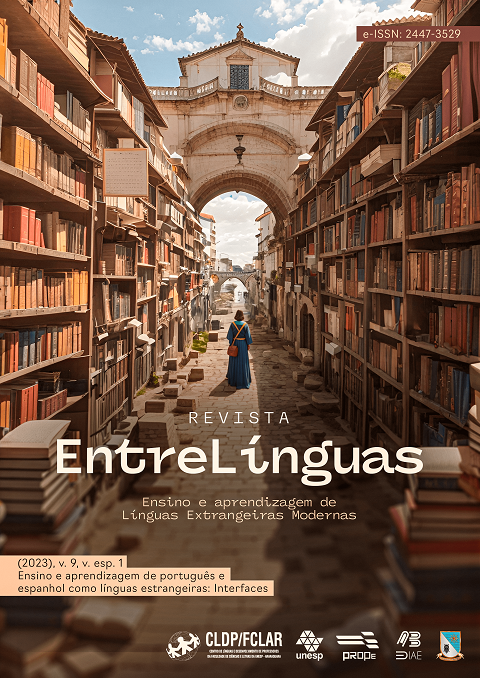From paremias, variants and synonyms
Interfaces between Portuguese and Spanish in the teaching and learning of PLE
DOI:
https://doi.org/10.29051/el.v9iesp.1.18633Keywords:
PLE, Proverb, Synonymous, Variant, Refranero MultilingüeAbstract
Having proverbs as the object of study and application in the teaching and learning of Portuguese as a Foreign Language (PLE), a proposal will be presented aiming to provide students with the opportunity to expand their vocabulary and refine their understanding of certain sententious statements, using the Spanish language as a bridge language. The choice of this language was based on the context of teaching Portuguese as a Foreign Language to groups of students from different countries around the world. The corpus to be worked on in the classroom will start with the presentation of proverbs in Portuguese known and published in the Refranero Multilingüe of the Cervantes Institute. Information on variants and synonyms of these sententious statements will be expanded through the students' research in the RM and in paremiographic repertoires in Portuguese and Spanish. This work will be based on studies by Teixeira de Faria (2021) on synonymy and variation and Sevilla Muñoz & Crida (2017) on the typology of proverbs, among others.
Downloads
References
ALMEIDA FILHO, J. C. Dimensões Comunicativas no Ensino de Línguas. 8. ed. Campinas, SP: Pontes Editores, 2015
ARNOLD, J. Affect in Language Learning. Cambridge: CUP, 1999.
BROWN, H. D. Teaching by principles: an interactive approach to language pedagogy. 3. ed. São Paulo: Pearson, 2007.
DULAY, H.; BURT, M.; KRASHEN, S. Language two. Oxford: Oxford University Press, 1982.
KRASHEN, S. Principles and Practice in Second Language Acquisition. Oxford: Prentice Hall, 1982.
MASGORET, A. M.; GARDNER, R. C. Attitudes, motivation and Second Language Learning: A meta-analysis of studies conducted by Gardner and Associates. Language Learning, v. 53, n. 1, p. 123-163, 2003. Disponível em: https://onlinelibrary.wiley.com/toc/14679922/53/1. Acesso em: 14 set. 2023.
ONWUEGBUZIE, A. J.; BAILEY, P.; DALEY, C. E. Factors associated with foreign language anxiety. Applied Psycholingustics, v. 20, p. 217-239, 1999. DOI: 10.1017/S0142716499002039.
SEVILLA MUÑOZ, J.; CRIDA ÁLVAREZ, C. A. Taxonomía de las paremias en lengua española. Phrasis, n. 1, p. 117-129, sep. 2017. Disponível em: http://www.phrasis.it/rivista/index.php/rp/article/view/18. Acesso em: 5 out. 2023.
TEIXEIRA DE FARIA, S. Ap. O uso e a criação de provérbios populares e frases proverbiais em Machado de Assis. In: TEIXEIRA DE FARIA, S. (Dir.). 500 Anos da Circum-Navegação do Mundo. Pesquisas em Linguística, Literatura e Cultura dos Países de Língua Portuguesa. Madrid, ES: APLEPES, 2021. p. 501-517.
YANG, N. D. The Relationship between EFL Learners’ Beliefs and Learning Strategy Use. System, v. 27, p. 515-535, 1999. Disponível em: https://www.sciencedirect.com/journal/system/vol/27/issue/4. Acesso em: 14 set. 2023.
Downloads
Published
How to Cite
Issue
Section
License

This work is licensed under a Creative Commons Attribution-NonCommercial-ShareAlike 4.0 International License.
Os manuscritos aceitos e publicados são de propriedade da Revista EntreLínguas. Os artigos publicados e as referências citadas na Revista EntreLínguas são de inteira responsabilidade de seus autores.
Transferência de direitos autorais – autorização para publicação
Caso o artigo submetido seja aprovado para publicação, já fica acordado que o(s) autor(es) autoriza(m) a UNESP a reproduzi-lo e publicá-lo na EntreLínguas, entendendo-se os termos “reprodução” e “publicação” conforme definição respectivamente dos incisos VI e I do artigo 5° da Lei 9610/98. O artigo poderá ser acessado pela rede mundial de computadores (Internet), sendo permitidas, a título gratuito, a consulta e a reprodução de exemplar do artigo para uso próprio de quem a consulta, desde que haja a citação ao texto consultado. Essa autorização de publicação 328 EntreLínguas, Araraquara, v. 1, n .2, p. 323-328, jul./dez. 2015 não tem limitação de tempo, ficando a UNESP responsável pela manutenção da identificação do(s) autor(es) do artigo. Os artigos publicados e as referências citadas na Revista EntreLínguas são de inteira responsabilidade de seus autores.











